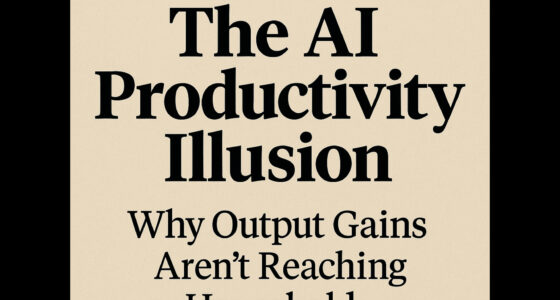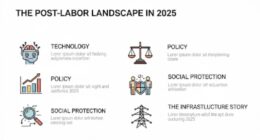As the economy shifts beyond traditional employment, you’ll see technology like AI and automation reshape industries, creating new job opportunities while displacing others. Societal changes foster diverse community support systems, and policymakers innovate to promote inclusivity and sustainability. Environmental challenges push for greener models and global cooperation. To thrive in this evolving landscape, continuous learning and adaptability become essential. Keep exploring to discover how these transformations could impact your future and opportunities ahead.
Key Takeaways
- Technological advances like AI and automation are reshaping industries, creating new job opportunities and displacing traditional roles.
- Remote and hybrid work models are becoming standard, influencing workforce distribution and talent acquisition strategies.
- Societal shifts focus on community support systems, health equity, and inclusive policies beyond traditional employment frameworks.
- Policy reforms and investments in infrastructure aim to promote economic resilience and address environmental challenges in a post-labor economy.
- Emphasizing human capital, digital literacy, and sustainable practices is vital for economic stability beyond traditional work structures.
The Shifting Landscape of Employment and Industry Dynamics

The landscape of employment and industry dynamics is rapidly changing, driven by a combination of economic adjustments, technological advances, and policy influences. You’ll notice that the labor force participation rate remains at 62.6%, with employment at 60%, signaling steady workforce engagement. In April 2025, nonfarm jobs grew by 177,000—well above expectations—highlighting resilience. Healthcare and social assistance lead employment gains, adding 58,200 jobs, while transportation and warehousing also saw significant growth. Conversely, manufacturing, especially nondurable goods, faces job declines, reflecting broader economic shifts. Public sector employment remains complex due to uncounted workforce changes. Overall, the labor market shows moderate demand, with job openings at 7.5 million, but hiring has slightly cooled, indicating a cautious but steady economic recovery. The unemployment rate remains steady at 4.2%, suggesting that the labor market is maintaining stability despite economic uncertainties. Additionally, exploring investment diversification strategies, such as incorporating Bitcoin IRAs, can provide further stability and growth opportunities amid these shifting industry trends. Moreover, understanding how drivetrain components wear and age can be crucial for maintaining bicycle performance over time, especially in varying storage conditions. Recognizing the importance of nutritional value of juices can also support a healthier lifestyle during times of changing work routines. In the context of technological innovation, the adoption of high-precision projectors for entertainment and workspaces exemplifies how evolving visual display technology influences both leisure and productivity. Furthermore, staying informed about topical authority ensures that content remains relevant and authoritative in a rapidly changing digital landscape.
Technological Transformations and Their Impact on Work

Advances in AI, automation, and digital technologies are reshaping how work is performed and organized across industries. Nearly all companies are investing in AI, yet few feel they’ve mastered its use. Over the next five years, AI is expected to create 19 million jobs while displacing 9 million, changing workforce dynamics. You’ll need to develop skills in AI-driven data analysis, a top-growing area. Automation and robotics are transforming industries by boosting efficiency and reducing labor costs, requiring workers to gain technological literacy and adaptability. As digital access accelerates globally, businesses depend heavily on AI and info processing for decision-making. These shifts are creating new economic models but also pose social challenges, including job displacement and inequality, urging organizations and society to adapt rapidly. Additionally, understanding the Law of Attraction principles can help individuals align with these technological changes and manifest opportunities in evolving industries. Recognizing the importance of digital literacy is crucial for navigating the rapidly changing job landscape and ensuring inclusive growth. Moreover, the increasing reliance on AI raises concerns about AI security vulnerabilities and biases that need ongoing attention to mitigate risks. Furthermore, a deeper awareness of industry-specific skills can facilitate smoother transitions into emerging job sectors. The integration of Natural Language Processing (NLP) enhances customer engagement and provides valuable insights for businesses, further influencing workforce needs and skills development.
Evolving Societal Structures and Community Adaptation

You see communities reshaping support systems to better serve families and individuals, especially new mothers. Policy adaptation strategies are emerging to address shifting needs and promote social equity. By strengthening community resources and inclusive policies, you can help foster more resilient and equitable societal structures that recognize diverse family forms and generational differences. Emphasizing community engagement ensures that policies are responsive and effectively meet the evolving needs of all demographic groups.
Community Support Systems
As communities adapt to changing demographics and needs, support systems evolve to better serve diverse populations. Postpartum and maternal health communities face shifting challenges, with women from various backgrounds experiencing distinct needs—physical recovery, emotional support, and childcare. Social support often comes from family and friends, but barriers like social isolation, cultural expectations, and resource access hinder mobilization. During COVID-19, support shifted to virtual platforms, maintaining connections despite physical distancing. Community-based care models, such as group prenatal care and doula programs, improve outcomes and promote equity, especially for low-income women. Workforce growth in community health sectors reflects rising demand for accessible care, though wages remain low. Organizations innovate continually, leveraging technology and replicating successful models to strengthen community networks beyond traditional support structures. The U.S. maternal mortality rate remains high, highlighting the ongoing need for expanded and culturally responsive support systems. Additionally, the integration of cybersecurity measures into community health initiatives ensures the protection of sensitive patient data as reliance on digital platforms increases, emphasizing the importance of safeguarding health information systems. Recognizing the role of dream symbols can also enhance understanding of individual needs and emotional well-being within these communities. Furthermore, incorporating community engagement strategies can foster trust and ensure services are tailored to local cultural contexts. Developing cultural intelligence within community health teams can further improve culturally responsive care and outreach efforts.
Policy Adaptation Strategies
Evolving societal structures demand adaptive policy strategies that effectively support postpartum women and their families. You can leverage state-level partnerships and provider training to implement successful programs, like LARC initiatives. Reimbursement strategies ensure healthcare providers stay engaged, while data evaluation guides continuous improvements. Cross-state collaboration fosters shared learning, enhancing postpartum care across regions. Incorporating innovative sound design techniques can also improve patient education materials, making information more engaging and accessible. Additionally, integrating predictive modeling can help identify individuals at higher risk, enabling proactive support and resource allocation. Recognizing the importance of market trends in healthcare innovation can further inform policy adjustments to meet evolving community needs. Incorporating asset division insights can also optimize resource distribution during community recovery efforts, ensuring equitable support systems. Moreover, understanding security zone concepts can help communities develop safer environments that promote well-being and resilience in post-labor recovery phases.
Social Equity Initiatives
Addressing social inequities in maternal and infant health requires targeted community adaptation initiatives that recognize and respond to persistent disparities. You can support community-based models like group prenatal care and culturally affirming postpartum services that foster trust and social connections. Expanding support services such as doula care helps improve health outcomes for marginalized groups. Economic empowerment programs and policy advocacy are essential to tackling systemic barriers and closing racial gaps in healthcare access, homeownership, and employment. Recognizing evolving societal structures—like increased workforce diversity and stronger union membership—can amplify these efforts. Additionally, integrating low light office plants into community health centers can contribute to improved indoor air quality and a calming environment that supports maternal well-being. Incorporating air quality enhancements through such plants can also help reduce stress and promote relaxation among new mothers. Promoting community engagement and fostering inclusive policies further strengthen these initiatives, helping create a more equitable environment where all communities, especially Black families, access the resources and support needed for healthier maternal and infant outcomes. Understanding the importance of affiliate disclosures and transparency can build trust and credibility within community programs, encouraging participation and support. Incorporating knowledge of traditional practices, such as the use of herbal remedies in some cultures, can also enhance culturally sensitive care approaches.
Policy Innovations and the Role of Governance in a Post-Labor World

Governments are developing innovative policies to navigate the shift into a post-labor economy, where traditional employment no longer dominates economic activity. They’re prioritizing workforce development by increasing federal funding, offering more flexibility to states, and aligning investments with post-secondary education. Technological infrastructure plays a essential role, with funding supporting tech support and innovation within workforce agencies. Legislation addressing maternal mental health, especially postpartum depression, is gaining momentum through Medicaid coverage and education. State legislatures are actively introducing bills to address social and economic issues, while policies aim to reduce systemic barriers and promote economic mobility. Data-driven decision making is central, enabling effective public investments. Overall, governance adapts to economic changes, focusing on resilience, social equity, and fostering new models to sustain growth beyond traditional employment. Incorporating creative storytelling into policy communication can enhance public engagement and understanding of these initiatives.
Environmental Opportunities and Sustainable Development

The planet faces urgent environmental challenges as greenhouse gas emissions soar and global temperatures surpass 1.5°C, driven largely by fossil fuel combustion and industrial agriculture. You must recognize that emissions have increased by 50% in 30 years, with 2024 being the hottest year on record. China accounts for about 31% of global fossil fuel CO₂ emissions, while deforestation destroys around 10 million hectares annually, mainly due to industrial agriculture. Sustainable development goals aim to restore biodiversity by 2050 and address water shortages expected to exceed supply by 40% by 2030. The rise of circular economy practices and consumer demand for eco-friendly products are transforming markets. To achieve these goals, significant private and public investments are essential, ensuring a sustainable future for both nature and society.
Addressing Inequality and Promoting Inclusive Growth

Environmental sustainability remains a pressing concern, but equally urgent is tackling the persistent inequalities within our societies. You can address these issues by understanding key challenges and solutions:
- Investing in human capital and education helps disadvantaged groups access better opportunities and reduces inequality.
- Infrastructure development, especially in the global South, promotes more equitable growth and reduces regional disparities.
- Policy reforms that empower workers and focus on sectoral reallocation can create a more inclusive economy.
Global Interdependence and International Collaboration

You need to recognize how global policy coordination is essential for managing shared economic and environmental challenges. Countries must work together on cross-border strategies to guarantee stability, sustainable growth, and resilience. Strengthening international collaboration helps address risks and open opportunities in our increasingly interconnected world.
Global Policy Coordination
Global policy coordination faces significant hurdles amid rising geopolitical tensions, economic uncertainties, and technological fragmentation. These challenges hinder effective international collaboration, making it harder to address global issues. You’ll find that geopolitical conflicts strain peace efforts, while a slowing global economy—projected at 2.4% growth in 2025—limits resources for cooperation. Technological fragmentation further complicates progress, as frontier tech development becomes siloed. Despite these obstacles, international frameworks like the Global Cooperation Barometer and climate agreements continue to promote dialogue and shared goals.
- Navigating geopolitical tensions while maintaining peace
- Overcoming economic slowdowns to fund joint initiatives
- Bridging technological gaps to enhance cooperation
Cross-Border Economic Strategies
As developing economies grow to represent nearly half of global GDP, their interconnectedness becomes essential for sustained worldwide stability. You’ll notice that over 40% of their exports go to other developing countries, doubling since 2000, which deepens regional ties. These nations are now key sources of capital flows, remittances, and aid, accounting for 40% of global remittances from 2019-2023. Increased trade and financial linkages boost mutual reliance and global integration. To visualize this, consider the following:
| Region | Key Growth Drivers | Strategic Focus |
|---|---|---|
| Latin America | Domestic demand, infrastructure | Cross-border investments |
| South Asia | Demographics, trade facilitation | Regional value chains |
| Sub-Saharan Africa | Urbanization, regional projects | Trade agreements, aid coordination |
Strengthening regional cooperation and trade policies is essential for resilience and shared prosperity.
Emerging Economic Models and Alternative Income Strategies

Emerging economic models in a post-labor era focus on leveraging automation, decentralization, and sustainable growth to reshape how value is created and distributed. By integrating AI and robotics, you can boost productivity and release human potential. Decentralization infrastructure supports local decision-making, reducing transaction costs and increasing efficiency. Reduced rent-seeking shifts focus from intermediaries to genuine value creation, fostering innovation through decentralized ownership, like open-source ecosystems. These models aim for sustainable growth by unblocking trapped economic value.
- Use automation and AI to enhance productivity and innovation
- Build decentralized systems to empower local markets and reduce costs
- Promote distributed ownership to encourage entrepreneurship and community-driven projects
Preparing for a Future of Flexible Work and Continuous Learning

Preparing for a future of flexible work and continuous learning requires adapting to rapid changes in technology and workplace expectations. You’ll need to embrace hybrid and remote work, which are growing—remote jobs increased from 10% to 15%, and fully in-office roles declined from 83% to 60%. Employers in rural areas now use flexibility to attract talent, while companies focus on developing hybrid norms to boost engagement. About 22.8% of U.S. employees work remotely part-time. To stay relevant, you must prioritize continuous learning, especially as AI and other tech evolve job roles. Nearly 70% of professionals consider changing careers, emphasizing the importance of skills development for job security and financial stability. Adapting to these shifts helps you thrive in the post-labor era’s flexible, dynamic work environment.
Frequently Asked Questions
How Will Universal Basic Income Influence Economic Stability in a Post-Labor Society?
Universal Basic Income can boost your economic stability by providing a reliable safety net, reducing income volatility, and supporting those in insecure jobs. It encourages you to pursue better opportunities without fear of losing essential income, which stabilizes the economy overall. While funding and potential labor shifts are concerns, a well-designed UBI helps you manage economic uncertainty, fostering resilience and a balanced, more stable post-labor society.
What New Industries Are Expected to Emerge in the Post-Labor Era?
They say, “the only constant is change,” and in a post-labor era, new industries will emerge. You’ll see growth in renewable energy, like solar and wind, driven by climate concerns. Robotics, AI, and biotech will create roles in automation, gene editing, and personalized medicine. Digital economy sectors—e-commerce, data science, and cloud computing—will flourish, shaping a future where innovation replaces traditional labor markets.
How Can Communities Effectively Adapt to Rapid Technological Changes?
You can help communities adapt to rapid technological changes by promoting continuous education and tech literacy programs. Encourage collaborative learning and establish innovation hubs for experimentation. Support workforce reskilling and develop strong digital infrastructure. Foster public-private partnerships and secure funding for innovative projects. Emphasize sustainable practices, use data analytics for informed decisions, and implement cybersecurity measures to protect systems, ensuring your community stays resilient and ready for ongoing technological advancements.
What Policies Are Best Suited to Support Displaced Workers Globally?
When it comes to supporting displaced workers globally, you need policies that hit the ground running. Focus on inclusive employment strategies, ensuring access to decent work and economic empowerment. Collaborate with international partners for funding and resources, and tailor programs to address climate change and long-term sustainability. By doing so, you can turn challenges into opportunities and help displaced communities not just survive, but thrive in their new environments.
How Will Environmental Sustainability Be Integrated Into the Evolving Economy?
You see, integrating environmental sustainability into the evolving economy involves adopting innovative technologies like AI and IoT to reduce emissions and optimize resource use. You’ll need to embrace circular economy models and prioritize transparency through mandatory ESG reporting. As regulations tighten, you’ll focus on sustainable practices that align with economic shifts away from traditional labor, fostering resilience and long-term value creation for your business and community.
Conclusion
As you step into this new world, remember that change is the only constant—like the tide, it reshapes everything. Embrace the shifts in work, technology, and society with an open mind and a resilient spirit. Your adaptability becomes your greatest asset, turning uncertainty into opportunity. The future isn’t set in stone; it’s yours to sculpt, a canvas waiting for your innovative touch. Ready to make your mark? The journey begins now.









